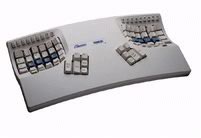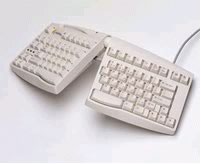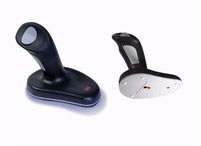|
Volume 11, Issue 3: Summer 2003 |
Subscribe to AT Messenger Download PDF Viewer |
Ergonomics in the Office
Dan Fendler, AT Specialist, Sussex County ATRC
We recently got new computers in all of the DATI Resource Centers. I was excited to get the new equipment with promise of quicker response times and lots of storage. Most of the new software requires both speed and space to run. After I finished setting up, and was eagerly waiting for the initial boot, I noticed a fluorescent orange tag on the keyboard. It read: "See bottom of keyboard for HEALTH WARNING". The first sentence of the warning on the back reads "Use of a keyboard or mouse may be linked to serious injuries or disorders." The rest of the warning explains that the repetitive use of a keyboard or mouse may cause repetitive stress injuries, like carpal tunnel syndrome.
After seeing this warning on a device that I use every day, I couldn't resist signing up for a session titled "Practical Ergonomics for Computer Use in the School and Office" at this years' Closing the Gap conference. I would like to take this opportunity to pass along some ideas that may help reduce the possibility of acquiring a musculoskeletal disorder (MSD), such as carpal tunnel syndrome, tendonitis, or tenosynovitis, associated with repetitive stress.
Ergonomics
First, lets take a look at the meaning of the word: er·go·nom·ics - an applied science concerned with designing and arranging things people use so that the people and things interact most efficiently and safely - called also human engineering. In other words, an ergonomic approach involves changing the tool to work with us, rather than changing us to work with the tool.
To demonstrate how you may be damaging the nerves in your hand, try the following: seated at a table or desk, put your hands palm down on the surface. Watch your forearm as you roll your hand from the palms down position to a position I'll call the "thumbs-up" position (just like you're giving someone the thumbs-up). Notice how your forearm twists. When you have your hands in a palms down position, you twist your forearm, which puts stress on the nerves running through your wrist. Keeping your hand in a neutral position (close to the thumbs up position) will reduce the stress to those nerves. Now, if you have a keyboard near you (assuming that you have a standard keyboard, not one that has a split design), put your hands on the home row keys. Notice how you turn your hand to accommodate the keyboard. Your hand is rotated down and turned to fit the keyboard. This puts stress on the nerves running into your hand. Using the keyboard everyday with your hand rotated and twisted can lead to MSDs. The same principles also apply to the use of a standard mouse.
If you use a computer every day, the bad news is that, with bad habits and old equipment, you could develop a debilitating condition. The good news is that there are lots of products that you can start using now to help reduce the overall risk.
Keyboards
There are a number of different keyboards available that help adapt the tool to your body.

Several examples include the Contoured Keyboard, the Goldtouch Keykoard and the Comfort Keyboard (all pictured). Each one accommodates a wide range of individual needs. The Goldtouch and the Comfort Keyboards adjust to allow maximum flexibility.

The best way to find one that works for you is to try them out. We have all three keyboards in our centers, available for loan.

Alternative Mice
Using a mouse that allows you to keep your hand in a more neutral position will help reduce stress as well. An example of one mouse is the Ergonomic Mouse (shown below). It looks like a joystick and let you keep your hand in a neutral position, which results in low pressure in the carpal tunnel.

There are a number of ergonometrically designed trackballs that will also help reduce stress. Many computer stores now carry a wide array of alternative mice and track balls.
How to Best Arrange Equipment
Assuming that you are seated in an appropriate chair, set the height of the work surface to accommodate the major activity (keyboarding vs. writing). If you spend more time writing, the work surface should be slightly above elbow level. If you use a keyboard more frequently, hold your upper arms straight down along your torso, keep your forearms parallel to the floor and that should give you a good idea of the proper keyboard height. Avoid reaching out or up. Keyboard trays are available and they allow for ready height adjustment, but also move the user away from everything else on the desk. When placing a mouse or trackball, you should follow the same guidelines as placing the keyboard. Do try to place it to minimize forward reach and rotation of the arm and shoulder.
When placing the monitor, if you use the computer most often, place it directly in front of you. If you spend more time with paper, place the monitor slightly to the side. In both cases, the top of the monitor should be 15 degrees below eye level (allows for dynamic movement of the head, a comfortable viewing position, and reduces dry eyes). At a minimum, try to keep the monitor at least an arm's length away.
Good Practices
Here are some basic ideas that can help reduce the possibility of acquiring a MSD:
- Keep everything within reach
- Work at proper heights
- Work in good postures
- Reduce excessive forces
- Minimize fatigue
- Reduce excessive repetition
- Provide clearance and access
- Minimize contact stress
- Provide mobility and change of positions
- Maintain a comfortable environment.
One source that has a number of alternative keyboards and mice is Infogrip (www.infogrip.com). An interesting source for ergonomic furniture is Office Organix (www.officeorganix.com).
As always, if you have any questions or need additional information, please feel free to contact your nearest ATRC.
Only Congressional Action Will Save DATI Services
The "Disability-Friendly" Workplace
Ergonomics in the Office
Inaugural Money Management Workshop A Great Success
Dealing with Standing Limitations
Inclusion Conference Scheduled for November
Technology in Literacy Education Grant Competition
NIDRR Seeks Input to Long-Range Plan
Resource for the Road: National Mobility Equipment Dealers Association
Did
You Know?
Access at the Gas Pump
Election Reforms Benefit Voters with Disabilities
Safe Transport for Children with Special Needs

